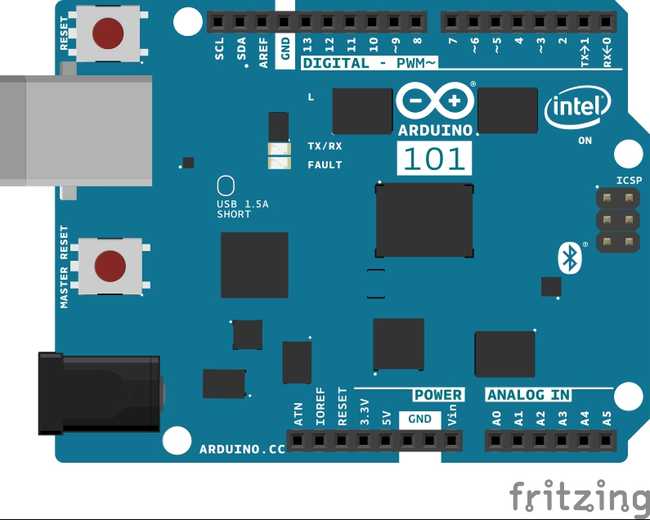Arduino 101 CurieIMU Tap detection
With this tutorial you learn how to detect double taps made on the board in a limited time interval and on any of the three axes.
With this tutorial you learn how to detect double taps made on the board in a limited time interval and on any of the three axes. This tutorial sets the accelerometer range for stronger taps and sets a window of a quarter of second to consider two taps as a double tap event.
Hardware Required
The Circuit

image developed using Fritzing. No additional hardware is needed to use this tutorial.
Software Essentials
Libraries
CurieIMU.h is the library that gives access to all the parameters, features and readings of the IMU chip of the 101 board. This unit contains a three axes accelerometer and a three axes gyroscope. This library is part of the 101 board core and it is loaded together with the core files for Arduino 101. In this tutorial we use the Tap detection feature of the IMU through the dedicated functions of this library.
Functions
None
Code
This sketch has the setup block that contains all the code necessary to set up the double tap detection event. The interrupt is enabled and when asserted is serviced by the callback function. This function reads all the possiple combinations of axes and direction to print on Serial port the axis and direction of the double tap. The main loop is empty.
1/*2
3 * Copyright (c) 2016 Intel Corporation. All rights reserved.4
5 * See the bottom of this file for the license terms.6
7 */8
9/*10
11 This sketch example demonstrates how the BMI160 accelerometer on the12
13 Intel(R) Curie(TM) module can be used to detect tap events14
15*/16
17#include "CurieIMU.h"18
19void setup() {20
21 Serial.begin(9600); // initialize Serial communication22
23 while(!Serial) ; // wait for serial port to connect.24
25 // Initialise the IMU26
27 CurieIMU.begin();28
29 CurieIMU.attachInterrupt(eventCallback);30
31 // Increase Accelerometer range to allow detection of stronger taps (< 4g)32
33 CurieIMU.setAccelerometerRange(4);34
35 // Reduce threshold to allow detection of weaker taps (>= 750mg)36
37 CurieIMU.setDetectionThreshold(CURIE_IMU_TAP, 750); // (750mg)38
39 // Enable Double-Tap detection40
41 CurieIMU.interrupts(CURIE_IMU_TAP);42
43 Serial.println("IMU initialization complete, waiting for events...");44}45
46void loop() {47
48 // nothing happens in the loop because all the action happens49
50 // in the callback function.51}52
53static void eventCallback()54{55
56 if (CurieIMU.getInterruptStatus(CURIE_IMU_TAP)) {57
58 if (CurieIMU.tapDetected(X_AXIS, NEGATIVE))59
60 Serial.println("Tap detected on negative X-axis");61
62 if (CurieIMU.tapDetected(X_AXIS, POSITIVE))63
64 Serial.println("Tap detected on positive X-axis");65
66 if (CurieIMU.tapDetected(Y_AXIS, NEGATIVE))67
68 Serial.println("Tap detected on negative Y-axis");69
70 if (CurieIMU.tapDetected(Y_AXIS, POSITIVE))71
72 Serial.println("Tap detected on positive Y-axis");73
74 if (CurieIMU.tapDetected(Z_AXIS, NEGATIVE))75
76 Serial.println("Tap detected on negative Z-axis");77
78 if (CurieIMU.tapDetected(Z_AXIS, POSITIVE))79
80 Serial.println("Tap detected on positive Z-axis");81
82 }83}84
85/*86
87 Copyright (c) 2016 Intel Corporation. All rights reserved.88
89 This library is free software; you can redistribute it and/or90
91 modify it under the terms of the GNU Lesser General Public92
93 License as published by the Free Software Foundation; either94
95 version 2.1 of the License, or (at your option) any later version.96
97 This library is distributed in the hope that it will be useful,98
99 but WITHOUT ANY WARRANTY; without even the implied warranty of100
101 MERCHANTABILITY or FITNESS FOR A PARTICULAR PURPOSE. See the GNU102
103 Lesser General Public License for more details.104
105 You should have received a copy of the GNU Lesser General Public106
107 License along with this library; if not, write to the Free Software108
109 Foundation, Inc., 51 Franklin Street, Fifth Floor, Boston, MA 02110-1301 USA110
111*/Suggest changes
The content on docs.arduino.cc is facilitated through a public GitHub repository. If you see anything wrong, you can edit this page here.
License
The Arduino documentation is licensed under the Creative Commons Attribution-Share Alike 4.0 license.